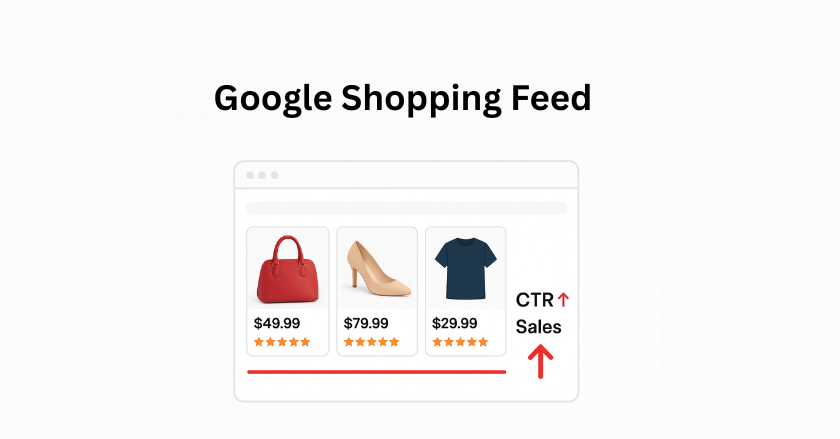Mastering Google Shopping Feed Optimisation to Drive More Sales
In the world of modern eCommerce, data accuracy and presentation make all the difference. Your products might be high-quality and competitively priced, but if they’re not visible to the right audience, your potential buyers may never find them. That’s where feed optimisation comes in.
A well-structured Google Shopping Feed acts as the foundation for successful Shopping Ads and free listings. It helps Google understand your products, match them with relevant search queries, and display them to high-intent shoppers across regions. Let’s explore how google shopping feed optimisation can help your store outperform competitors and drive consistent sales growth.
Quick Summary
Optimising your product feed ensures every item in your store is accurately represented and easily discoverable on Google Shopping. When your data is complete, keyword-rich, and localized, your products reach the right customers at the right time, increasing visibility, clicks, and conversions.
Anchor Text: Discover powerful strategies for Google Shopping feed optimisation to enhance product visibility and maximise online performance.
Why Optimising Your Feed Matters
Your Google Shopping Feed isn’t just a data file it’s your product catalogue that Google uses to decide when and where to show your products. A poorly structured feed can limit reach, waste ad spend, and even result in disapprovals.
When your feed is optimised correctly, it tells Google precisely what you sell, where you sell it, and who it’s meant for. This means your ads appear more often in relevant searches, your click-through rate increases, and your cost per conversion drops.
Feed optimisation gives you a competitive advantage, ensuring that your products stand out among thousands of listings in your niche.
Core Elements of Google Shopping Feed Optimisation
1. Product Titles That Match Buyer Intent
Your title is one of the strongest ranking signals in Google Shopping. Create titles that clearly describe your product and match real user search intent. Include attributes such as brand, product type, and features.
Example: “Samsung Galaxy A15 128GB Smartphone Blue”
2. Accurate and Engaging Descriptions
Your product description should explain features, benefits, and specifications concisely. Use natural, descriptive language that appeals to shoppers while including relevant search terms.
3. Clean, High-Quality Product Images
Images are often the deciding factor in a shopper’s click. Use professional images with clear backgrounds and accurate representations. Avoid watermarks or text overlays.
4. Correct Category and Attributes
Assign your products to the most specific Google Product Category. Add attributes like color, size, gender, material, and brand to help Google match your listings to relevant searches.
5. Price and Availability Consistency
Ensure your pricing and stock levels match your website. Inaccurate data leads to disapproval and poor user experience. Update your feed regularly to maintain accuracy.
How Optimisation Improves Performance
An optimised feed improves both visibility and engagement. When titles, descriptions, and attributes align with user intent, your products appear in more relevant search results. Shoppers who find exactly what they’re looking for are more likely to click and buy.
Over time, optimised feeds generate better data quality scores in Google Merchant Center, improving both organic placements and paid Shopping Ad performance. Consistency in your feed also builds customer trust, leading to higher conversion rates.
Geo Relevance and Local Targeting
If you sell in multiple countries or regions, localising your Google Shopping Feed is essential. This means using local currency, regional shipping details, and language variations that align with user searches.
For example, a product targeting the UK market should display prices in GBP and mention delivery timelines suitable for UK customers. Similarly, a feed optimised for Pakistan should include PKR and local courier options.
Localisation improves search visibility, relevance, and conversion rates by ensuring customers see information that feels tailored to them.
Steps to Improve Your Google Shopping Feed
- Audit your current feed Identify missing data, errors, and low-performing attributes.
- Revise titles and descriptions Use precise language and focus on keyword relevance.
- Add identifiers Include GTIN, MPN, and brand for every product.
- Enhance imagery Replace poor-quality visuals with professional images.
- Localise your feed Adapt currencies, measurements, and language to your target regions.
- Automate updates Schedule regular feed uploads to avoid outdated pricing or stock data.
- Monitor performance Use Google Merchant Center diagnostics to find and fix issues quickly.
Common Mistakes to Avoid
- Using vague or generic product titles
- Leaving attributes blank (brand, GTIN, or color)
- Uploading low-quality or mismatched product images
- Ignoring region-specific pricing or shipping info
- Failing to update the feed regularly
Avoiding these common issues helps maintain feed accuracy, prevent disapprovals, and improve ad delivery quality.
Final Thoughts
Your Google Shopping feed optimisation strategy can be the difference between an underperforming campaign and a thriving eCommerce business. A well-optimised feed not only increases visibility but also ensures your products appear before the right audience boosting your return on ad spend and improving overall profitability.
By focusing on clean data, local relevance, and consistent updates, your Google Shopping Feed becomes a powerful tool for scaling your brand in competitive markets.
Start refining your feed today, and let Google do the rest by delivering your products to the shoppers who are ready to buy.
FAQs
- What is Google Shopping feed optimisation?
It’s the process of refining your product feed so Google can accurately display your products in relevant searches, improving visibility and conversions. - How often should I update my feed?
Ideally, you should update it daily or whenever product details such as price, stock, or images change. - Why are product titles important?
Titles are a key ranking factor in Google Shopping. A well-structured title increases your product’s chances of appearing in relevant searches. - How can localisation improve my Shopping Feed?
Localising your feed with regional currencies, languages, and shipping options helps target audiences more effectively in different countries. - What happens if my feed contains errors?
Errors can lead to product disapprovals, reduced visibility, or account suspensions. Regular monitoring helps prevent such issues.

